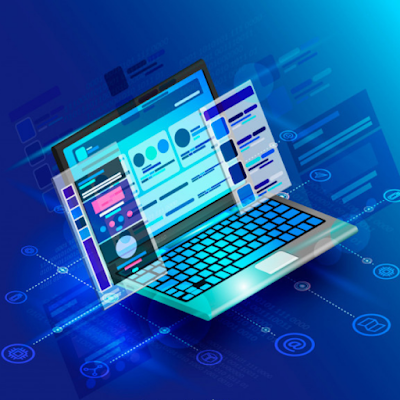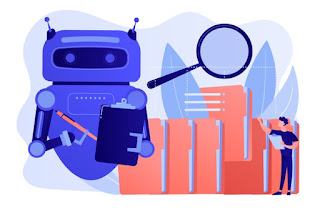As we know that Artificial Intelligence helps Industries in many ways
and makes our industrial tasks easier and more efficient. This is only because
we adopting AI technologies. Nowadays many Engineers want to start a career in
these technologies and that is the main reason Artificial Intelligence and
machine learning becoming trending technologies these days. Only because of
these demands, it becoming the biggest boom in the market. By 2021, AI-enabled
tools alone are expected to produce $2.9 trillion in business value. 80% of
companies spend smartly on AI.
Artificial Intelligence has completely transformed the way of software industry operations. As per software development experts, the software development life cycle (SDLC) has tremendous benefits with Artificial Intelligence. It bought accuracy, speed, and efficiency to the entire SDLC (Software Development Life Cycle). Instead of correcting errors in the code, AI enables developers to concentrate on design and feature construction. In delivering large-scale and error-free applications without delay, this approach has greatly benefited companies providing custom software development services.
Traditionally, creating a computer program requires you to specify
exactly what you want the system to do in advance and then manually engineer
all the features of your technology. It is possible to encode many tasks in an
explicit way since computers were still quite powerful before the advent of
AI.
Here we discuss how artificial intelligence can improve the software development process:
Automated Code Generation
Taking a business idea and writing the code for an enormous project is time-consuming and labor-intensive. Developers are approaching to opt for a solution that helps write code before beginning production in order to save time and dollars. With the complexity of what the aim of the target objective is to collect this information that, if you write the code from scratch, can be very time-consuming.
By automating code generation and detecting bugs from the code, AI-based
assistance reduces these loads to some extent. Take an example of a project
where it can be interpreted by translating the concept into executable code in
your natural language and framework.
Generate Unique Software Design
Designers need to apply their advanced learning and expertise to create
alternative ideas in software engineering, preparing a project and developing
it from scratch, before deciding on a definitive solution.
A designer begins with a solution vision, and then retracts and forwards
the investigation of plan changes until the desired solution is reached. A
tedious and mistake-prone action for designers is to decide on the correct plan
decisions for each step.
A few AI advances have shown the benefits of developing conventional approaches with intelligent specialists along this line. The catch here is that the operator conducts the customer as an individual partner. This partner should have the opportunity to provide sufficient input on the most professional method of designing projects.
Take the AI Design Assistant (AIDA) example, most designers are able to
understand the client's needs and preferences as well as use the same to design
a similar project. AIDA serves as a website building platform that helps
to explore various software design combinations by providing the required
personalized design according to customer requirements.
Software Testing
The central part of every software development cycle is testing. A big problem for development teams in the identification and avoidance of errors or bugs. Fixing bugs and errors consists of a large amount of software development costs. Throughout the development life cycle, early error detection requires continuous monitoring. Current software testing activities, however, are expensive, costly, and time-consuming since errors are discovered in the code in several instances after the product has been developed and distributed to the mass market.
In less time than manual testing, AI and Machine Learning algorithms
will ensure that the test conducted is error-free, allowing code testers to
concentrate on more critical tasks such as maintaining code. Prototypes of
AI-enabled code testing allow development teams to conduct mass tests on
thousands or millions of codes. Development teams can deal with case-specific
experiments, whereas routine and time-consuming tests can be done by
AI-assisted automation instruments. Ultimately, this results in a decrease in
errors because AI-assisted tests scope and correct errors with sheer accuracy,
leading to an increase in overall software quality improvement.
For instance, with AI-enabled cloud testing, DeepCode assists developers to quickly test and release working code. Software testers use a parameter template test plan and add the code to an AI tool, which transforms the code into a working test case automatically and fixes specific bugs. Engineers are sent requests for approval for bug fixes immediately, and subsequent deployment to production. Not only does this save time, money, and energy, but the organization also generates a high ROI.
GUI Testing
In communicating with today's applications, Graphical User Interfaces (GUI) have become important. They are increasingly used in sensitive systems and it is important to test them in order to avoid failures. Testing GUIs is difficult with very few tools and techniques available to help in the testing process.
Currently, GUI testing methods are ad hoc.
The methods of GUI testing currently used are ad hoc. They require the
test designer to perform humongous tasks, such as manually designing test
cases, identifying the conditions to be verified during the test execution,
determining when to check these conditions, and finally assessing whether the
GUI software is properly tested. Phew! Phew! That's a great deal of work
now.
Applitools is an AI-empowered GUI tester tool. The Applitools Eyes SDK
automatically checks whether or not the visual code is running correctly.
Applitools allows users to test their visual code as extensively as their
usable UI code to guarantee that the application's visual look is as you intend
it to be. To ensure that they all suit the template, users can test how their
application looks in different screen formats.
Deployment Control
Machine learning and AI technologies have also had some effects on the deployment of software, such as an improvement in the efficacy of deployment control activities. The deployment process in the software development paradigm is the stage where developers often update programs or applications to newer versions. By analyzing details such as statistics from prior code releases and application logs, AI-powered tools help predict deployment failure ahead of time. In the case of a failure, this can speed up root cause analysis and recovery. In one instance, automated deployment and rollback verification based on machine learning helped an e-commerce company achieve faster application delivery and a 75 percent decrease in mean-time-to-restore from a development environment failure. In manufacturing, AI can also help applications run optimally. A machine learning-based tool has been deployed by another online company that analyzes various possible application runtime settings and automatically deploys optimal environment settings. This allowed them to halve the cost of clouds and more than double the efficiency of applications.
Requirement Gathering
As a conceptual process of SDLC, the gathering of requirements involves full human interaction. A wide variety of techniques/tools such as Google ML Kit and Infosys Nia are provided by artificial intelligence to automate certain procedures to eliminate human interference to some degree. This stage requires a lot of attention on the early identification of loopholes before moving to design. An AI method called Natural Language Processing can allow machines to understand the specifications of the user in natural language and extract high-level software models automatically. There are, of course, some problems with this approach, including difficulties in balancing the systems created.
Conclusion
Artificial intelligence tends to have a huge influence on software design and development. Software development companies are expected to take on the possible advantages of AI, which is a game-changer in the development of software.
Also Read: Uses of Artificial Intelligence and Machine Learning in Airline Industry
Apart from this if you want to start your career in Machine Learning and want to do a course then join “Nearlearn”. Nearlearn is the Foremost Artificial Intelligence Training Institute in Bangalore and also the best Machine Learning Training institute. They provide both online training and classroom training facilities. After completion, of course, they help you to get placement in various companies.
For more information contact us:
Visit: www.nearlearn.com







